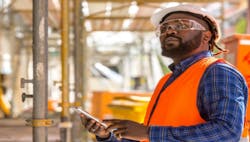Using proximity monitoring to turn work zones into safe zones during COVID
As states lift COVID-19 restrictions and allow employees back to work, 60% of employers plan to have some personnel work at the company’s facility—whether that be a factory, a warehouse or an office, according to a recent IDC survey of IT professionals and business decision makers.
But it will definitely not be business as usual. In the post-COVID world, companies are working hard to implement strategies that improve worker safety while increasing the personal level of comfort as staffs remain socially distanced at work.
Fortunately, technology can help. A wide range of proximity-monitoring solutions have emerged that help workers remain safe by socially distancing to help reduce the spread of COVID-19. Companies that are committed to keeping employees safe while avoiding unnecessary shutdowns should look for full-scale solutions that support four crucial levels of protection:
Automated employee alerts
Proximity solutions that trigger an alarm when an employee moves within six feet of another employee are essential to keeping people safely spaced. These solutions allow employees to monitor their own “social distancing” practices, which helps them to feel in control. But these solutions lose effectiveness if an employee chooses to ignore the alarm. They also do not reveal when a particular job or work area needs to be redesigned to reduce employee contact and improve safety.
Event tracking to uncover danger areas
These problems can be solved by implementing the second level of proximity monitoring, which involves tracking computer-generated proximity “events.” Such events are generated, for example, when employees are in close proximity over a period of five minutes or longer. When uploaded into the cloud and viewed via secure, user-friendly dashboards or reports, this event data allows authorized users at companies to easily spot patterns or locations where social distancing is repeatedly violated. Employers can then investigate what is causing the violation—and fix the problem by changing employee behavior, workflows, or workplace design.
Immediate contact tracing to limit spread
In the unfortunate case that an employee tests positive for COVID-19, good contact tracing can help save lives and reduce unnecessary downtime. In today’s production facilities, just one positive test can shut down an entire line. But a good monitoring solution allows businesses to use proximity data to determine the level of risk of potential exposure to their workers. Data-based contract tracing can also potentially limit widespread facility closures, as employees who were not exposed will not require quarantining. In addition to reducing unnecessary downtime and helping limit the spread of COVID-19, monitoring solutions save time and improve accuracy, as opposed to associates having to perform these tasks manually.
Streamline sanitization to eliminate surface contamination
The fourth aspect of reducing proximity-related infections is eliminating infections that occur due to exposure to contaminated surfaces. Technology can help companies promote increased sanitization and disinfection of shared mobile devices or work areas. As arriving employees sign in for a shift, they should be able to readily identify if a device is fit for use during the check-in process and associate the device to themselves for the day. At the end of their shifts, the employees transition their device status to “requires sanitization” as part of the check-out process. This helps ensure that employers send the devices through the proper sanitization processes after their associates are done using the devices each day—speeding up shift changes and reducing the chance of spreading the virus via contact with a contaminated surface.
Cloud-based solutions help support COVID-19 efforts
Unfortunately, many proximity solutions that require additional hardware such as cameras or new sensing equipment can become costly for businesses. They can also require bringing in outside vendors who could potentially introduce an infection risk. Budget- and safety-conscious companies should consider software-based solutions—such as cloud-based solutions that communicate with mobile apps installed on company hardware that do not require the installation of additional infrastructure.
Companies must also take privacy into account when monitoring employee proximity. Solutions should support compliance with existing privacy regulations by allowing data to be anonymized to protect both employees and employers. Personal information about an employee’s health should be kept between the employer and the employee.
Proximity monitoring can reduce the spread of COVID-19 up to 90% over six weeks, according to a mathematical analysis by Oxford University. That is why in the months to come, we will see more businesses use proximity-monitoring technology to help keep their workers safe—especially in manufacturing and warehousing facilities, where working from home is not an option. Full-scale, cloud-based software applications that support alerts, event tracking, contract tracing and disinfection checks provide the most complete protection for both employees and businesses.
By Michael Frank, senior manager portfolio management for location solutions, Zebra Technologies
